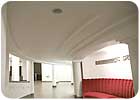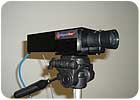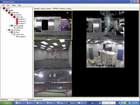What Youll Use Next for Early Fire Detection May Surprise You

Flush-mount smoke detectors are used in the ceiling of the BOZAR Centre for Fine Arts in Brussels, Belgium.

This flush-mount smoke detector uses light that is not in the visible range to create a holographic chamber.
“You can do early detection if you’re willing to put up with more false alarms,” concedes Tom Hauder, product marketing manager for fire, Bosch Security Systems Inc., Fairport, N.Y. “But we see technology taking over with earlier detection and still avoiding that false alarm issue.”
Combining different types of detection in a single unit, called multi-sensor technology, is one approach that has achieved some success towards this purpose. Putting photoelectric smoke with carbon monoxide (CO) detection in the same unit can indicate through high levels of CO whether a fire actually is occurring.
Another method of reducing false alarms is drift compensation, which readjusts the alarm setpoint of a smoke detector to take into account the dust that accumulates in the chamber where the particulate level is sampled. This is important because the scattering pattern of light in the chamber can set off an alarm.

A conventional four-wire photoelectronic duct smoke detector uses low-flow technology in this factory.
Certain devices combine heat and smoke detection in one unit, but some in the industry think this is unnecessary. “If you generate enough heat to set off the heat detector, the smoke detector will have gone by then,” points out Tim Frankenberg, fire product manager, fire alarm line for Potter Electric Signal Co., St. Louis.
“The way to look at a heat detector is it is designed to protect property more than people,” asserts Jeff Van Keuren, sensor products, marketing development leader for GE Security, Bradenton, Fla.
“A heat detector requires something already be burning, that flames be happening, whereas a smoke detector is designed to be an early detection device, and either a fire is smoldering or it has not flashed over, and the ability to pick that up is the difference between heat and a regular photoelectric smoke detector.

The photoelectric smoke detector has a thermal sensor and built-in sounder for sensitive applications like this classroom.
Van Keuren thinks methods of eliminating known false alarms are being developed for specific situations. “What you’re seeing worldwide is people are incorporating more and more different sensors to eliminate known false alarms, such as steam and cigarette smoke,” he points out.
“One of the big trends is the ability to incorporate or separate those sensors,” Van Keuren notes. His employer, GE Security, offers a unit that combines photoelectric and ionization smoke detectors with heat detection.
“The other trend is to individualize the sensors depending on what kind of hazard you’re trying to solve,” he explains. Dusty industrial environments require different solutions than offices.

This advanced horn/strobe is a two-wire model with selectable horn and strobe settings for locations like this bar.
WHOLLY SMOKES
The market for wireless and addressable smoke detectors is growing faster than the market for conventional ones, declares Richard Roberts, product manager for System Sensor, St. Charles, Ill.“The conventional smoke detector category has been relatively flat, he reports. “And that trend has been pretty consistent over the last five or six years.”
The fewer wires on a smoke detector, the easier it is to install. “The trend that we have seen again over the last four or five years is that people really prefer two-wire smokes over four-wire smokes, because you have to run less conductors to the smoke detector,” Roberts points out.
“The two-wire detector receives its operating power from the initiating circuit, and because it does, it has to be compatibility-listed with the control panel,” he explains. Four-wire smoke detectors are used mainly in retrofit applications, so they do not have to be compatibility-listed with an existing control panel.
Smoke detectors that use ionization rather than photoelectric sensors are being used less in commercial applications.

This production version of an IP network camera from axonX LLC, Sparks, Nev., is going through FM and UL testing.
Sidebar: The Next Big Thing Is Here: Video Smoke Detection
Major security equipment manufacturers may think video smoke detection is in its early stages, but those companies supplying it say it is here.“We have installed over 250 of these systems worldwide, and sales are rapidly accelerating,” replies Ian Moore, managing director of Detector Technologies Ltd. (D-Tec), Alton, Hampshire, United Kingdom, which claims to have invented the technology.
“For all large open areas, video smoke detection is the perfect application due to the efficiency of detection and the cost of installation in comparison with standard forms of detection,” Moore continues. “For this reason, there is a huge untapped market, some of it previously unsolvable, such as external smoke detection.”
Robert Dannenfelser, global product services manager for axonX LLC, Sparks, Md., another manufacturer of different video smoke detection equipment, agrees.
“We have conducted literally thousands of tests spread over several years in all kinds of locations,” he declares. “Installations include a basketball arena, a uranium processing plant, a lumber yard and a horse farm.”
“As building designs continue to develop in complexity and scale, conventional forms of detection may start to meet their optimum performance thresholds,” Moore maintains.
Installations of D-Tec’s technology in the United States include power station turbine halls, theme parks in Florida and oil recycling plants in Canada.

The newest version of the unlicensed and unrestricted monitoring program used by axonX LLC, Sparks, Nev., shows the blue outline of a smoke cloud and purple boxes identifying reflected fire light.
“Critical events are sent to the NetVu Observer so that the operator can make an informed decision on what to do within the environment,” Moore explains.
axonX’s technology is in a DVR that has received Factory Mutual (FM) approval and in an IP camera, Dannenfelser notes.
D-Tec’s system has received approvals from FM, British standard BS5839, national approvals from China, Japan, Australia and South Africa, and is listed in NFPA 72 for smoke and flame detection.
“Our technology is true video detection, not infrared, not simple motion detection,” Dannenfelser insists. “It has multiple patented algorithms that see flame, smoke or motion. When it sees smoke, it will provide an outline of the smoke cloud.
“It will draw a box around the flame, and even if it can’t see a flame but can see the reflected firelight, it will identify that as a fire,” he continues.
Video smoke detection usually is used as a supplemental system. Tom Hauder, product marketing manager for fire, Bosch Security Systems Inc., Fairport, N.Y., is enthused about the technology.
“Video smoke detection is going to be the big comer,” Hauder predicts. “We’re doing our research on it and working with one of the leading companies doing that type of research.
“There are some very special places it will work, but you can’t just stick one in a room like a beam or spot detector,” he asserts. “The algorithms aren’t quite there yet, but it will happen. I really think that is the coming thing because combining those types of technologies makes sense.”
“Video smoke detection has been used as the primary source of detection, where no other form of detection could be used,” Moore relates, many of whose installations are not in the United States or Canada. “However, the normal use is as a supplementary system and connected to the fire alarm system as part of it.”
“It can act in a preemptive manner and detect flame, smoke and motion,” Dannenfelser asserts. “So you could think of it as a security system on steroids.”

Colored mirrors are used in addition to color filters in the CSS series of strobes with mass notification speakers from Potter Electric Signal Co., St. Louis.
Sidebar: Mass Notification Market Expected to Grow
Mass notification systems for emergencies other than fire are being specified more, especially since the Department of Defense (DOD) has published its unified facilities criteria.“Any of the big defense contractors like Lockheed Martin have been adding mass notification concepts, such as audio supervision, into their building and campus plans for some time,” explains John Weaver, director of marketing for Gamewell FCI, Northford, Conn.
“Mass notification is one of the hottest things going right now,” agrees Tim Frankenberg, fire product manager, fire alarm line for Potter Electric Signal Co., St. Louis. “There’s really a market that is just beginning to be tapped.”
Although mass notification is not new, its recent importance has made it seem so, says Lance Kaiser, director of marketing for Signal Communications Corp., Woburn, Mass. “It’s enormous in its potential,” Kaiser says of mass notification.
An annex of recommendations for the design of mass notification systems has been added to the new edition of NFPA 72, which was issued late last year.
Voice evacuation systems are used in fire emergencies, whereas mass notification systems are designed for other types of emergencies, such as chemical spills, terrorist incidents or employees or students with guns.

ADT’s Clear Warning public address system is deployed outdoors at U.S. military installations around the world.
Mass notification systems can include live or recorded voice announcements over outdoor loudspeakers or indoor sound systems, text messaging, e-mail blasts or even electric signs.
Locations for mass notification systems include power plants, train stations, airports, high-rises, campuses, retail facilities, schools, churches, sports stadiums and assembly complexes, “Anyplace where you have a lot of people together and you need to communicate concisely and rapidly,” Weaver asserts.
Mass notification is a capability that usually is added to an existing fire control panel through software. In many cases, the speakers it uses already may be installed for fire emergencies or be part of notification devices like horn strobes.
“People are talking about it a lot and trying to figure out whether it is something they need to consider in their life-safety plans, work environment or publicly occupied space,” Weaver says of mass notification systems. “It’s just kind of starting out. There’s going to be a lot of feedback.”
Kaiser agrees that mass notification has not really caught on yet for industrial sites. “We regard it as a pretty small part of the business,” Weaver continues. “I would say that among the voice evacuation systems maybe in the next five years, I’d guess up to half of them could be mass-notification-capable – the addressable side of the market and voice evacuation market are both expected to grow at a rate that’s higher than just regular conventional fire panels.”

A test engineer for Gamewell FCI, Northford, Conn., works on a mass notification system.
“Typically, amber, red and blue are used, sometimes green, primarily with egress-type of situations more so than in access,” Frankenberg relates.
Differently colored strobes have been used for weather warnings in factories or for different types of fire alarms.
ADT Security Services, Boca Raton, Fla., is using a mass notification system whose intelligibility and volume is consistent next to the speakers or hundreds of feet from them. The company says it is anticipating growth in that marketplace.
Looking for a reprint of this article?
From high-res PDFs to custom plaques, order your copy today!



